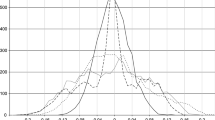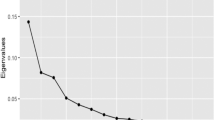Abstract
The aim of this paper is to apply an algorithm related to the rational approximation for the identification of the lag structure in a transfer-function model. In fact, we apply the ε-algorithm proposed by Berlinet [3–5] to determine the polynomial orders in univariate and multivariate ARMA models. Furthermore, it has been proposed by Berlinet [5], González and Cano [13, 14] and González et al. [15] for a transfer-function model with one input and multiple inputs, respectively.
The main contribution in this paper concerns the study of the relative significance of the elements in the ε-algorithm table, in the same way as that given by Berlinet and Francq [7] for ARMA models, to confirm the pattern used to specify the model. Two examples will be considered, namely, the sales series M [8] and a simulated model [20].
A comparison is also made between the results of the ε-algorithm and the corner method generally used in the econometric literature. Although the ε-algorithm requires a more advanced theory in Numerical Analysis, it can be applied in a more simple way than the corner method.
Similar content being viewed by others
References
G.A. Baker, Jr. and P. Graves-Morris, Padé approximants. Part I: Basic theory. Part II: Extensions and applications, in:Encyclopedia of Mathematics and its Applications, vols. 13 and 14 (Addison-Wesley, Reading, 1981).
J.M. Beguin, C. Gourieroux and A. Monfort, Identification of a mixed autoregressive-moving average process: The corner method, in:Time Series, ed. O.D. Anderson (North-Holland, Amsterdam, 1980) pp. 423–426.
A. Berlinet, Une méthode de determination des degrés d'un modèle ARMA, Publications IRMA, Lille, vol. 3 fasc. 6 (1981) pp. 423–436.
A. Berlinet, Estimating the degrees of an ARMA model, Compstat. Lect. 3 (1984) 61–94.
A. Berlinet, Some useful algorithms in time series analysis, in:Alternative Approaches to Time Series Analysis, Pub. des Facultés Universitaires Saint-Louis, Belgique (1984) pp. 95–120.
A. Berlinet, Sequence transformations as statistical tools, Appl. Numer. Math. 1 (1985) 531–544.
A. Berlinet and C. Francq, Identification of a univariante ARMA model, Comp. Stat. 9 (1994) 117–133.
G.E.P. Box and G.M. Jenkins,Time Series Analysis: Forecasting and Control, revised edition (Holden Day, San Francisco, 1976).
C. Brezinski,Padé-type Approximations and General Orthogonal Polynomials (Birkhäuser, Basel, 1980).
C. Brezinski and M. Redivo Zaglia,Extrapolation Methods. Theory and Practice (North-Holland, Amsterdam, 1991).
P. Claverie, D. Szpiro and R. Topol Identification des modèles à fonction de transfert: la mèthode Padé-transformée enz, Ann. Econ. Statis. 17 (1990) 145–161.
F.R. Gantmacher,Matrix Theory, Vol. 2 (Chelsea, 1974).
C. González and V. Cano, Determinación de los órdenes de los polinomios de retardo en una Función de Transferencia: Comparación de algoritmos, Rev. Acad. Canaria de Ciencias 1 (1990) 173–183.
C. González and V. Cano, Especificación de una función de transferencia bajo limitación en el comportamiento de la variable dependiente, Departamento de Economía Aplicada, Universidad de La Laguna (1990).
C. González, V. Cano and C. Gil, Comparación de algoritmos para la identificación de una función de transferencia: una generalización al caso de varios inputs, Rev. Española de Economía 10 (1993) 163–175.
C. Gourieroux and A. Monfort, Series temporelles et modèles dynamiques,Collection “Economie et Statistiques Avancées” (Ed. Economica, Paris, 1990).
D. Hanssens and L. Liu, Lag specification in rational distributed lag structural models. J. Bus. Econ. Statist. 1 (1983) 316–325.
L.D. Haugh and G.E.P. Box, Identification of dynamic regression (distributed lag) models connecting two time series, J. Amer. Statist. Assoc. 74 (1977) 652–660.
K. Lii, Transfer Function model order and parameter estimation, J. Time Series Anal. 6(3) (1985) 153–169.
L. Liu and D. Hanssens, Identification of multiple inputs transfer function models, Comm. Statist. A 11 (1982) 297–314.
B. Mareschal, Identification et aide à la decision multicritère, Cahiers du C.E.R.O. 28 (1986) 153–162.
B. Mareschal and G. Mélard, The corner method for identifying autoregressive moving average models, Appl. Statist. 37 (1988) 301–316.
R.S. Tsay, Model identification in dynamic regression (distributed lag) models, J. Bus. Econ. Statist. 3 (1985) 228–237.
P. Wynn, On a device for computing thee m (s n ) transformation, MTAC 10 (1956) 91–96.
Author information
Authors and Affiliations
Additional information
Communicated by C. Brezinski
Rights and permissions
About this article
Cite this article
Concepción, C.G., Fernández, V.C. & Fariña, C.G. The ε-algorithm for the identification of a transfer-function model: some applications. Numer Algor 9, 379–395 (1995). https://doi.org/10.1007/BF02141597
Received:
Revised:
Issue Date:
DOI: https://doi.org/10.1007/BF02141597




